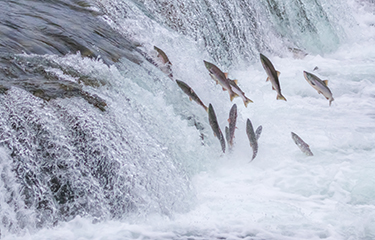Low prices are marring another banner year of returns for Alaska’s salmon fisheries.
Forecasts for catches of sockeye, chum, and pink salmon have all been exceeded, with more than 201 million total salmon caught through 25 August, already far above the 2022 total of 163.2 million fish and exceeding the 192 million salmon caught in 2021.
More than 49.6 million sockeye have been landed in Alaska this season, down from 72.5 million in 2022 but above the forecasted total of 48 million sockeye, with ongoing late-run fisheries still reporting solid catch totals. The pink salmon season is winding down with around 133.2 million salmon caught, nearly double the 69.5 million caught in 2022, helped by its odd-year return cycle, and coming in above the fishery’s 122-million-fish preseason prediction. And 16.6 million chum have been caught through 25 August, above the 14.9 million caught in 2022 and bettering the 16-million-fish preseason prediction from the Alaska Department of Fish and Game.
Additionally, 185,000 king salmon have been caught, which exceeded a preseason forecast of 78,000, and 1.2 million coho have been caught in 2023, coming in below expectations 3 million coho would be caught. The seasonal average prices by species across Alaska has been: USD 5.76 (EUR 5.32) per pound for king salmon; USD 1.60 (EUR 1.48) per pound for coho salmon; and USD 0.55 (EUR 0.51) per pound of chum salmon, according to the Alaksa Department of Fish and Game.
Despite the strong numbers, few in Alaska’s salmon industry are celebrating.
Low prices offered by processors for sockeye salmon angered many fishermen, and a collapse in the pink salmon market, caused by a confluence of high inventory levels and low demand, have collectively resulted in many fishermen working less than they typically would, or not fishing at all.
“I’ve been in the industry a long time, and I’ve never seen markets like this,” Trident CEO Joe Bundrant said in his company’s mid-August announcement it would delay upgrading several processing facilities in Alaska. “The rate and pace at which markets are collapsing across our key species is staggering. Not only are global inventories and operating costs high, but demand is low; some are selling at or below cost just to generate cash.”
Trident dropped its price for chum salmon USD 0.20 (EUR 0.19) per pound in response to massive harvests in Russia and announced it will stop buying salmon across most of Alaska – except for Petersburg and Cordova South – beginning 1 September, according to KMXT. Furthmore, Trident said it ...
Photo courtesy of Sekar B/Shutterstock








